Monopolies, Duopoly, and Oligopolies in Australia: An Analysis
VerifiedAdded on 2020/03/13
|9
|1413
|116
Report
AI Summary
This report analyzes the market structures in Australia, focusing on monopolies, duopolies, and oligopolies, particularly within the telecommunications sector. It examines the dominance of Telstra and the rise of Optus, potentially transforming the market into a duopoly. The report reviews economic concepts like the kinked demand curve in oligopolies and the market power of monopolies. It also discusses market concentration in duopolies. The analysis includes recommendations for both Telstra and Optus to maintain and improve their market positions by focusing on pricing and service quality. The report concludes that the Australian telecom industry is transitioning, offering consumers more choices and potentially breaking Telstra's monopoly. References to relevant articles are provided.
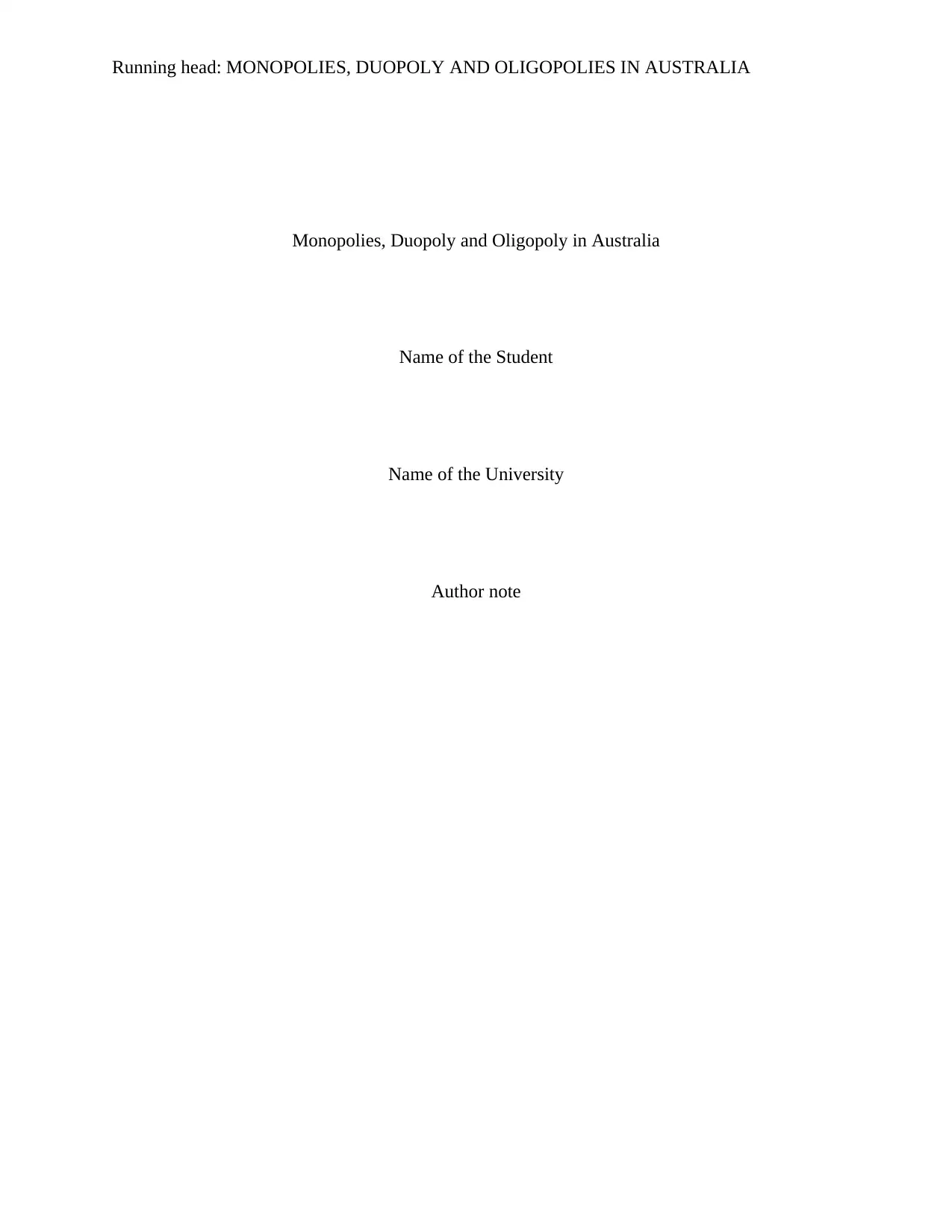
Running head: MONOPOLIES, DUOPOLY AND OLIGOPOLIES IN AUSTRALIA
Monopolies, Duopoly and Oligopoly in Australia
Name of the Student
Name of the University
Author note
Monopolies, Duopoly and Oligopoly in Australia
Name of the Student
Name of the University
Author note
Paraphrase This Document
Need a fresh take? Get an instant paraphrase of this document with our AI Paraphraser
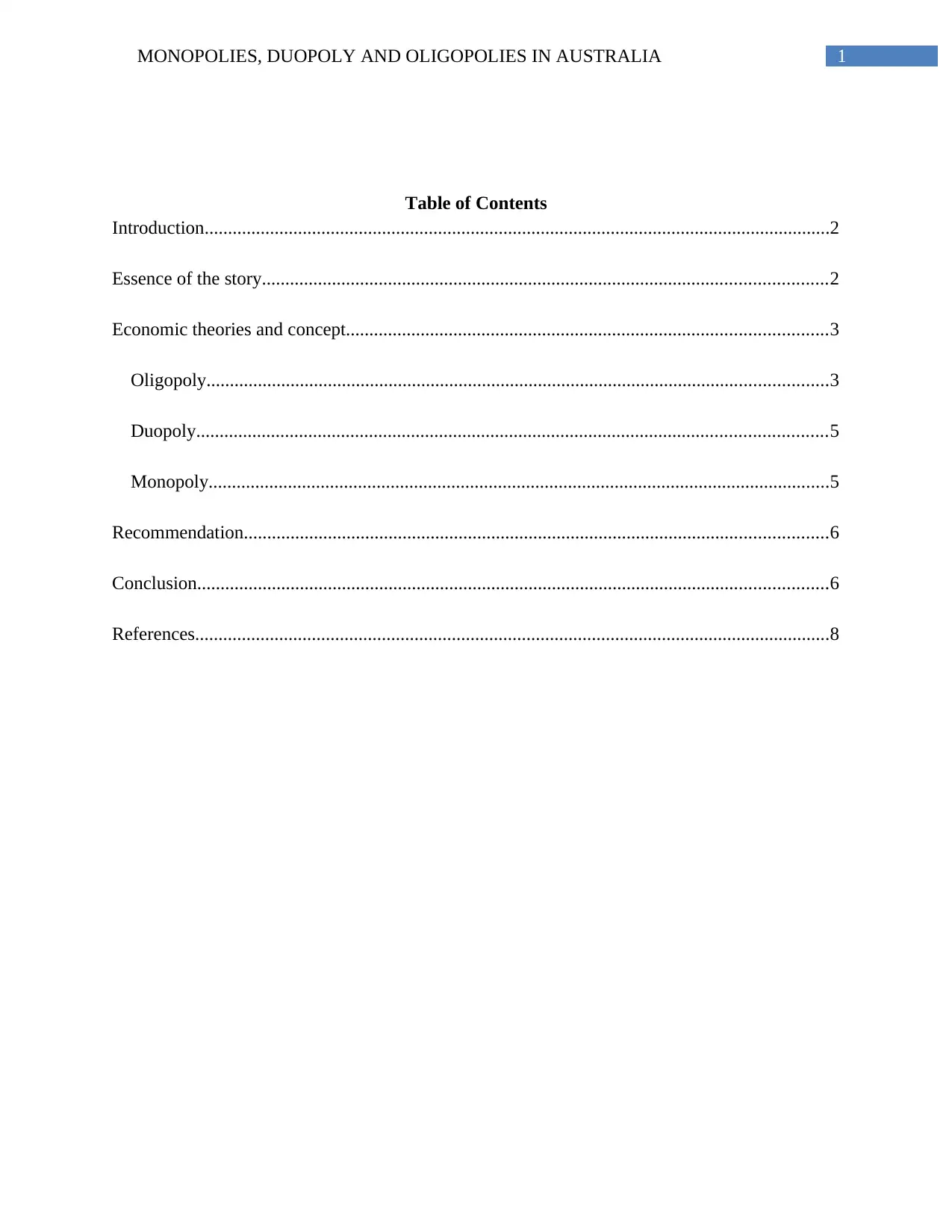
1MONOPOLIES, DUOPOLY AND OLIGOPOLIES IN AUSTRALIA
Table of Contents
Introduction......................................................................................................................................2
Essence of the story.........................................................................................................................2
Economic theories and concept.......................................................................................................3
Oligopoly.....................................................................................................................................3
Duopoly.......................................................................................................................................5
Monopoly.....................................................................................................................................5
Recommendation.............................................................................................................................6
Conclusion.......................................................................................................................................6
References........................................................................................................................................8
Table of Contents
Introduction......................................................................................................................................2
Essence of the story.........................................................................................................................2
Economic theories and concept.......................................................................................................3
Oligopoly.....................................................................................................................................3
Duopoly.......................................................................................................................................5
Monopoly.....................................................................................................................................5
Recommendation.............................................................................................................................6
Conclusion.......................................................................................................................................6
References........................................................................................................................................8
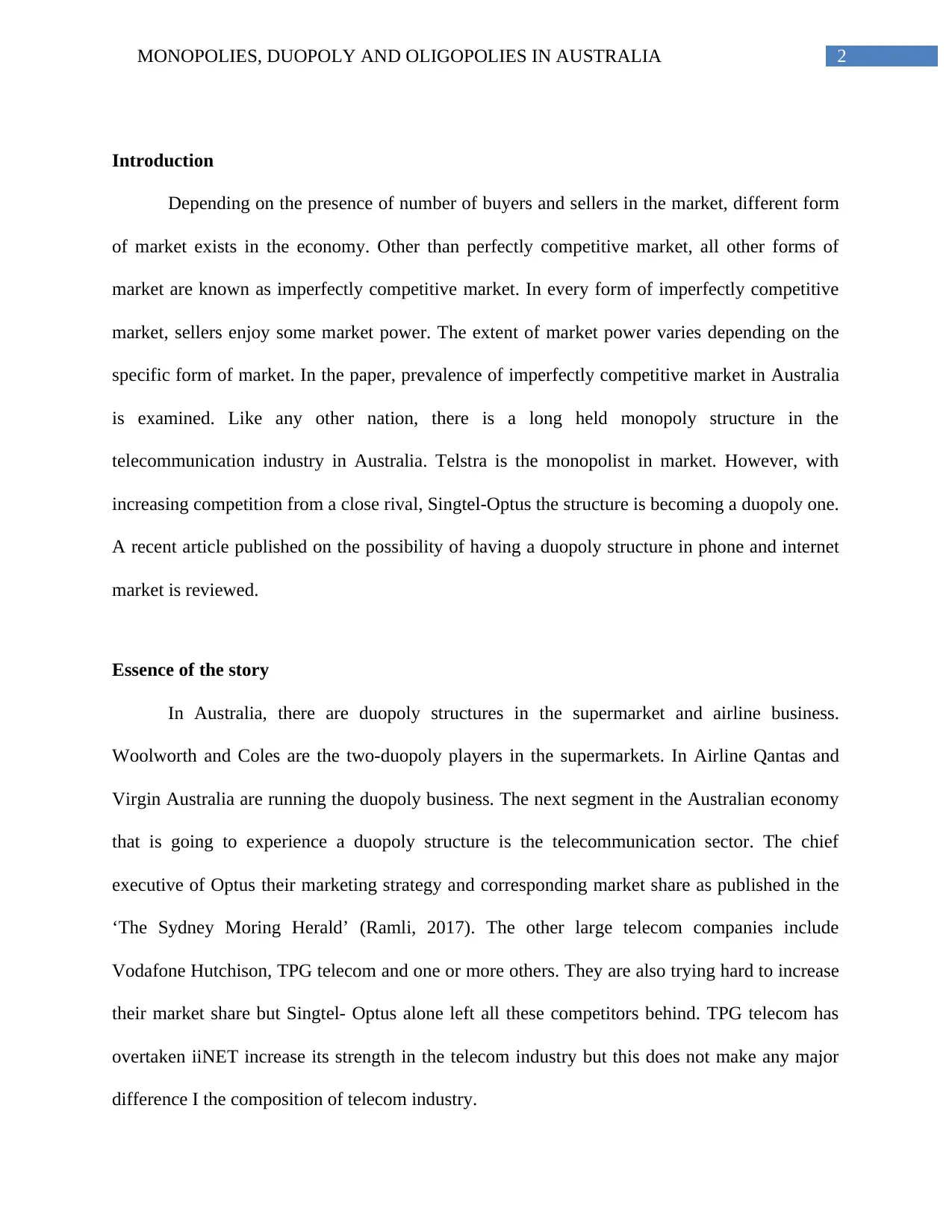
2MONOPOLIES, DUOPOLY AND OLIGOPOLIES IN AUSTRALIA
Introduction
Depending on the presence of number of buyers and sellers in the market, different form
of market exists in the economy. Other than perfectly competitive market, all other forms of
market are known as imperfectly competitive market. In every form of imperfectly competitive
market, sellers enjoy some market power. The extent of market power varies depending on the
specific form of market. In the paper, prevalence of imperfectly competitive market in Australia
is examined. Like any other nation, there is a long held monopoly structure in the
telecommunication industry in Australia. Telstra is the monopolist in market. However, with
increasing competition from a close rival, Singtel-Optus the structure is becoming a duopoly one.
A recent article published on the possibility of having a duopoly structure in phone and internet
market is reviewed.
Essence of the story
In Australia, there are duopoly structures in the supermarket and airline business.
Woolworth and Coles are the two-duopoly players in the supermarkets. In Airline Qantas and
Virgin Australia are running the duopoly business. The next segment in the Australian economy
that is going to experience a duopoly structure is the telecommunication sector. The chief
executive of Optus their marketing strategy and corresponding market share as published in the
‘The Sydney Moring Herald’ (Ramli, 2017). The other large telecom companies include
Vodafone Hutchison, TPG telecom and one or more others. They are also trying hard to increase
their market share but Singtel- Optus alone left all these competitors behind. TPG telecom has
overtaken iiNET increase its strength in the telecom industry but this does not make any major
difference I the composition of telecom industry.
Introduction
Depending on the presence of number of buyers and sellers in the market, different form
of market exists in the economy. Other than perfectly competitive market, all other forms of
market are known as imperfectly competitive market. In every form of imperfectly competitive
market, sellers enjoy some market power. The extent of market power varies depending on the
specific form of market. In the paper, prevalence of imperfectly competitive market in Australia
is examined. Like any other nation, there is a long held monopoly structure in the
telecommunication industry in Australia. Telstra is the monopolist in market. However, with
increasing competition from a close rival, Singtel-Optus the structure is becoming a duopoly one.
A recent article published on the possibility of having a duopoly structure in phone and internet
market is reviewed.
Essence of the story
In Australia, there are duopoly structures in the supermarket and airline business.
Woolworth and Coles are the two-duopoly players in the supermarkets. In Airline Qantas and
Virgin Australia are running the duopoly business. The next segment in the Australian economy
that is going to experience a duopoly structure is the telecommunication sector. The chief
executive of Optus their marketing strategy and corresponding market share as published in the
‘The Sydney Moring Herald’ (Ramli, 2017). The other large telecom companies include
Vodafone Hutchison, TPG telecom and one or more others. They are also trying hard to increase
their market share but Singtel- Optus alone left all these competitors behind. TPG telecom has
overtaken iiNET increase its strength in the telecom industry but this does not make any major
difference I the composition of telecom industry.
⊘ This is a preview!⊘
Do you want full access?
Subscribe today to unlock all pages.

Trusted by 1+ million students worldwide
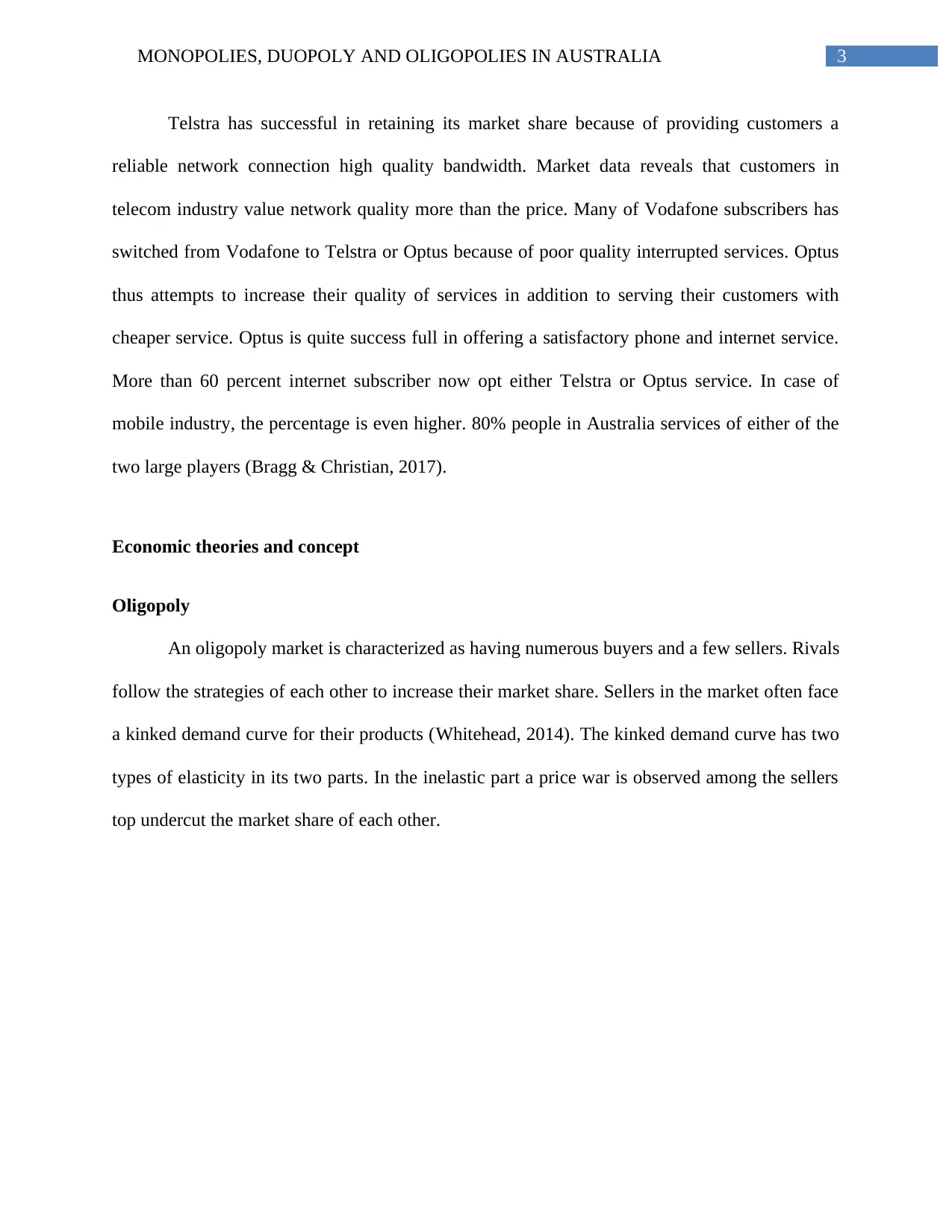
3MONOPOLIES, DUOPOLY AND OLIGOPOLIES IN AUSTRALIA
Telstra has successful in retaining its market share because of providing customers a
reliable network connection high quality bandwidth. Market data reveals that customers in
telecom industry value network quality more than the price. Many of Vodafone subscribers has
switched from Vodafone to Telstra or Optus because of poor quality interrupted services. Optus
thus attempts to increase their quality of services in addition to serving their customers with
cheaper service. Optus is quite success full in offering a satisfactory phone and internet service.
More than 60 percent internet subscriber now opt either Telstra or Optus service. In case of
mobile industry, the percentage is even higher. 80% people in Australia services of either of the
two large players (Bragg & Christian, 2017).
Economic theories and concept
Oligopoly
An oligopoly market is characterized as having numerous buyers and a few sellers. Rivals
follow the strategies of each other to increase their market share. Sellers in the market often face
a kinked demand curve for their products (Whitehead, 2014). The kinked demand curve has two
types of elasticity in its two parts. In the inelastic part a price war is observed among the sellers
top undercut the market share of each other.
Telstra has successful in retaining its market share because of providing customers a
reliable network connection high quality bandwidth. Market data reveals that customers in
telecom industry value network quality more than the price. Many of Vodafone subscribers has
switched from Vodafone to Telstra or Optus because of poor quality interrupted services. Optus
thus attempts to increase their quality of services in addition to serving their customers with
cheaper service. Optus is quite success full in offering a satisfactory phone and internet service.
More than 60 percent internet subscriber now opt either Telstra or Optus service. In case of
mobile industry, the percentage is even higher. 80% people in Australia services of either of the
two large players (Bragg & Christian, 2017).
Economic theories and concept
Oligopoly
An oligopoly market is characterized as having numerous buyers and a few sellers. Rivals
follow the strategies of each other to increase their market share. Sellers in the market often face
a kinked demand curve for their products (Whitehead, 2014). The kinked demand curve has two
types of elasticity in its two parts. In the inelastic part a price war is observed among the sellers
top undercut the market share of each other.
Paraphrase This Document
Need a fresh take? Get an instant paraphrase of this document with our AI Paraphraser
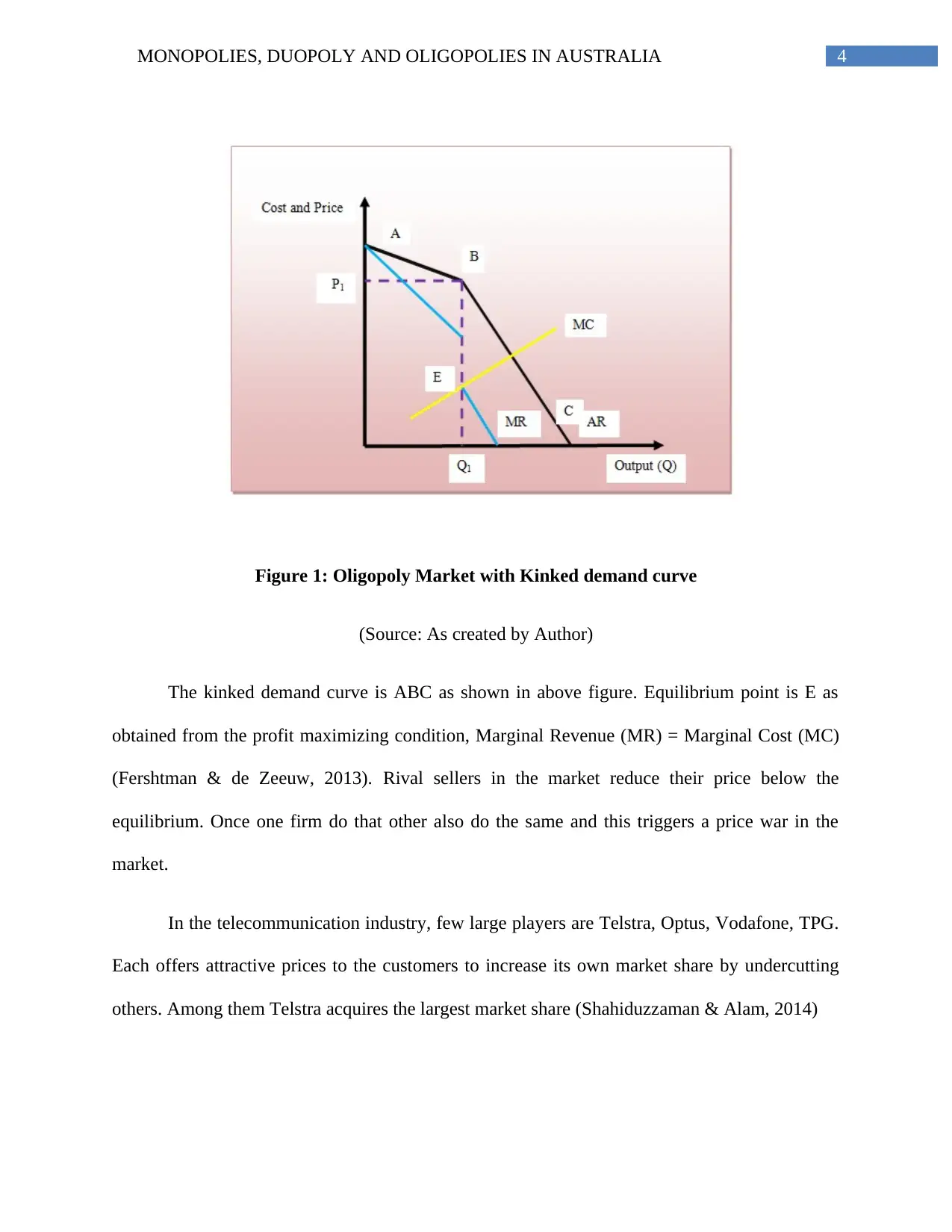
4MONOPOLIES, DUOPOLY AND OLIGOPOLIES IN AUSTRALIA
Figure 1: Oligopoly Market with Kinked demand curve
(Source: As created by Author)
The kinked demand curve is ABC as shown in above figure. Equilibrium point is E as
obtained from the profit maximizing condition, Marginal Revenue (MR) = Marginal Cost (MC)
(Fershtman & de Zeeuw, 2013). Rival sellers in the market reduce their price below the
equilibrium. Once one firm do that other also do the same and this triggers a price war in the
market.
In the telecommunication industry, few large players are Telstra, Optus, Vodafone, TPG.
Each offers attractive prices to the customers to increase its own market share by undercutting
others. Among them Telstra acquires the largest market share (Shahiduzzaman & Alam, 2014)
Figure 1: Oligopoly Market with Kinked demand curve
(Source: As created by Author)
The kinked demand curve is ABC as shown in above figure. Equilibrium point is E as
obtained from the profit maximizing condition, Marginal Revenue (MR) = Marginal Cost (MC)
(Fershtman & de Zeeuw, 2013). Rival sellers in the market reduce their price below the
equilibrium. Once one firm do that other also do the same and this triggers a price war in the
market.
In the telecommunication industry, few large players are Telstra, Optus, Vodafone, TPG.
Each offers attractive prices to the customers to increase its own market share by undercutting
others. Among them Telstra acquires the largest market share (Shahiduzzaman & Alam, 2014)
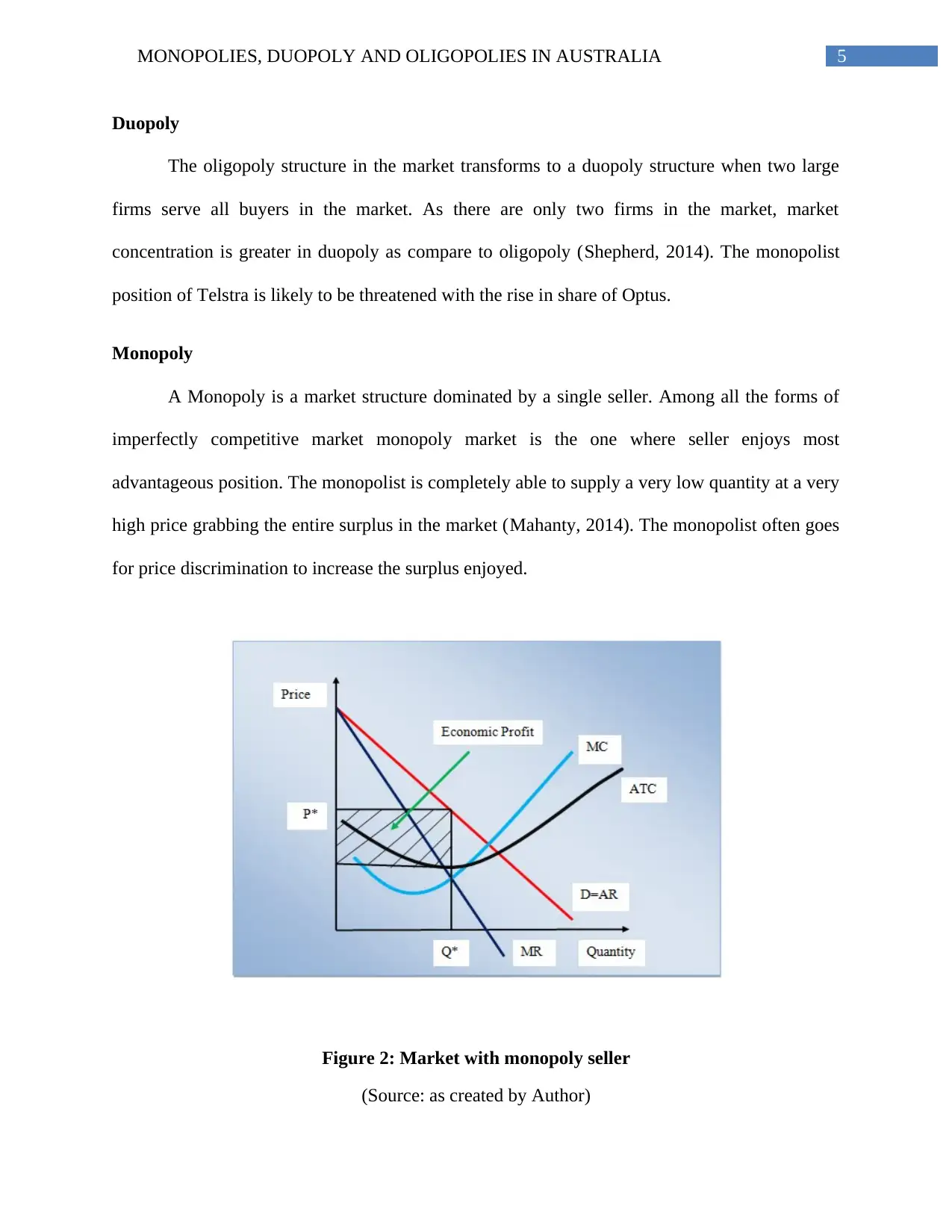
5MONOPOLIES, DUOPOLY AND OLIGOPOLIES IN AUSTRALIA
Duopoly
The oligopoly structure in the market transforms to a duopoly structure when two large
firms serve all buyers in the market. As there are only two firms in the market, market
concentration is greater in duopoly as compare to oligopoly (Shepherd, 2014). The monopolist
position of Telstra is likely to be threatened with the rise in share of Optus.
Monopoly
A Monopoly is a market structure dominated by a single seller. Among all the forms of
imperfectly competitive market monopoly market is the one where seller enjoys most
advantageous position. The monopolist is completely able to supply a very low quantity at a very
high price grabbing the entire surplus in the market (Mahanty, 2014). The monopolist often goes
for price discrimination to increase the surplus enjoyed.
Figure 2: Market with monopoly seller
(Source: as created by Author)
Duopoly
The oligopoly structure in the market transforms to a duopoly structure when two large
firms serve all buyers in the market. As there are only two firms in the market, market
concentration is greater in duopoly as compare to oligopoly (Shepherd, 2014). The monopolist
position of Telstra is likely to be threatened with the rise in share of Optus.
Monopoly
A Monopoly is a market structure dominated by a single seller. Among all the forms of
imperfectly competitive market monopoly market is the one where seller enjoys most
advantageous position. The monopolist is completely able to supply a very low quantity at a very
high price grabbing the entire surplus in the market (Mahanty, 2014). The monopolist often goes
for price discrimination to increase the surplus enjoyed.
Figure 2: Market with monopoly seller
(Source: as created by Author)
⊘ This is a preview!⊘
Do you want full access?
Subscribe today to unlock all pages.

Trusted by 1+ million students worldwide
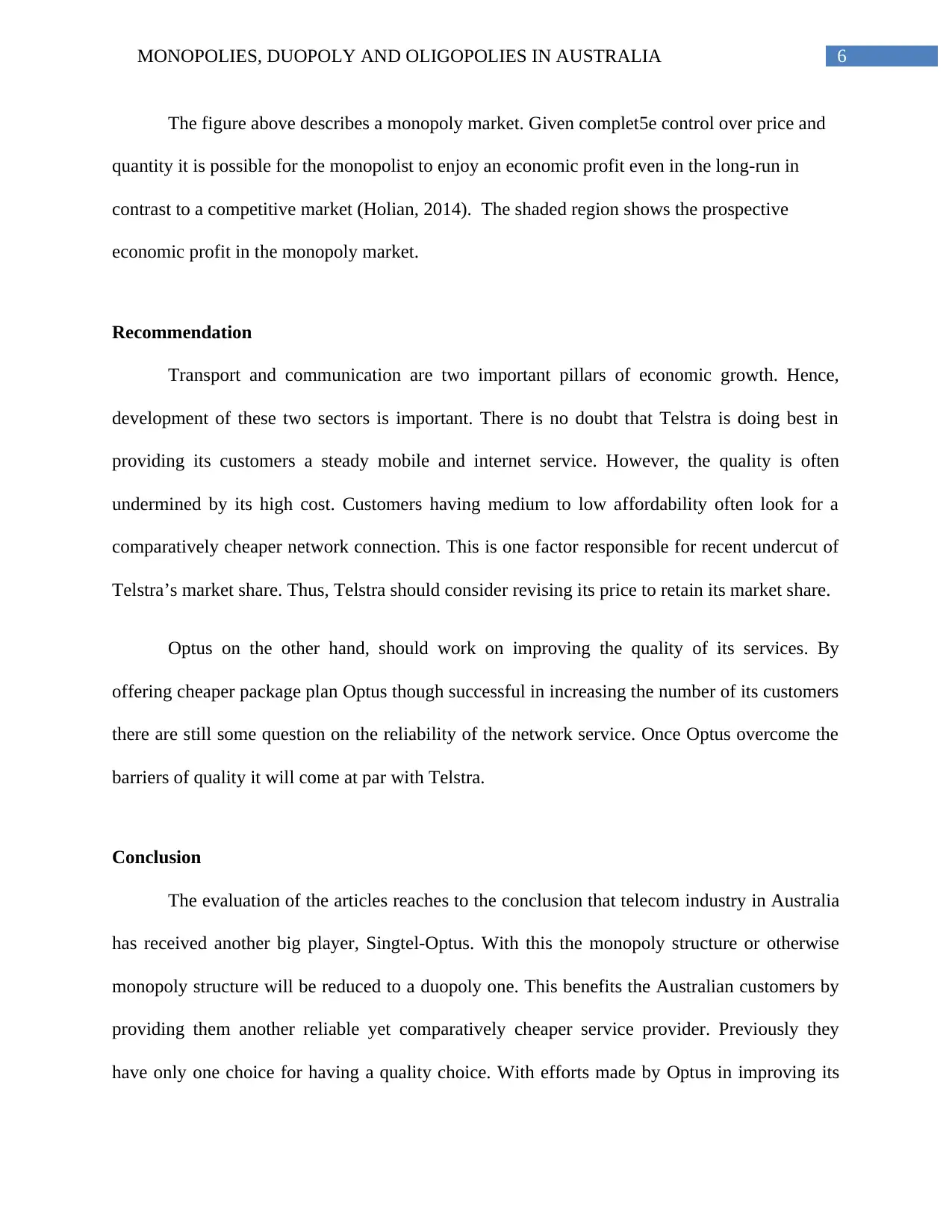
6MONOPOLIES, DUOPOLY AND OLIGOPOLIES IN AUSTRALIA
The figure above describes a monopoly market. Given complet5e control over price and
quantity it is possible for the monopolist to enjoy an economic profit even in the long-run in
contrast to a competitive market (Holian, 2014). The shaded region shows the prospective
economic profit in the monopoly market.
Recommendation
Transport and communication are two important pillars of economic growth. Hence,
development of these two sectors is important. There is no doubt that Telstra is doing best in
providing its customers a steady mobile and internet service. However, the quality is often
undermined by its high cost. Customers having medium to low affordability often look for a
comparatively cheaper network connection. This is one factor responsible for recent undercut of
Telstra’s market share. Thus, Telstra should consider revising its price to retain its market share.
Optus on the other hand, should work on improving the quality of its services. By
offering cheaper package plan Optus though successful in increasing the number of its customers
there are still some question on the reliability of the network service. Once Optus overcome the
barriers of quality it will come at par with Telstra.
Conclusion
The evaluation of the articles reaches to the conclusion that telecom industry in Australia
has received another big player, Singtel-Optus. With this the monopoly structure or otherwise
monopoly structure will be reduced to a duopoly one. This benefits the Australian customers by
providing them another reliable yet comparatively cheaper service provider. Previously they
have only one choice for having a quality choice. With efforts made by Optus in improving its
The figure above describes a monopoly market. Given complet5e control over price and
quantity it is possible for the monopolist to enjoy an economic profit even in the long-run in
contrast to a competitive market (Holian, 2014). The shaded region shows the prospective
economic profit in the monopoly market.
Recommendation
Transport and communication are two important pillars of economic growth. Hence,
development of these two sectors is important. There is no doubt that Telstra is doing best in
providing its customers a steady mobile and internet service. However, the quality is often
undermined by its high cost. Customers having medium to low affordability often look for a
comparatively cheaper network connection. This is one factor responsible for recent undercut of
Telstra’s market share. Thus, Telstra should consider revising its price to retain its market share.
Optus on the other hand, should work on improving the quality of its services. By
offering cheaper package plan Optus though successful in increasing the number of its customers
there are still some question on the reliability of the network service. Once Optus overcome the
barriers of quality it will come at par with Telstra.
Conclusion
The evaluation of the articles reaches to the conclusion that telecom industry in Australia
has received another big player, Singtel-Optus. With this the monopoly structure or otherwise
monopoly structure will be reduced to a duopoly one. This benefits the Australian customers by
providing them another reliable yet comparatively cheaper service provider. Previously they
have only one choice for having a quality choice. With efforts made by Optus in improving its
Paraphrase This Document
Need a fresh take? Get an instant paraphrase of this document with our AI Paraphraser
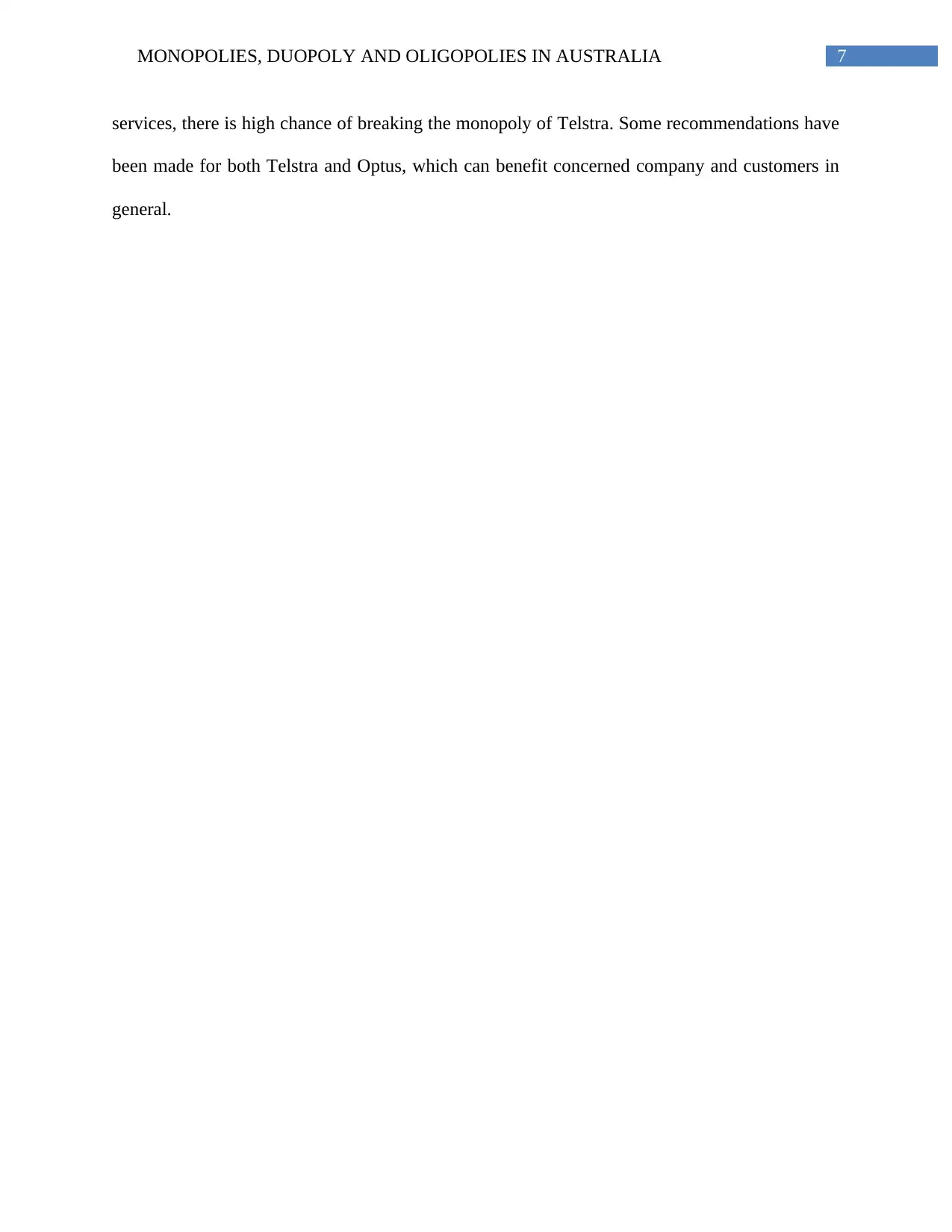
7MONOPOLIES, DUOPOLY AND OLIGOPOLIES IN AUSTRALIA
services, there is high chance of breaking the monopoly of Telstra. Some recommendations have
been made for both Telstra and Optus, which can benefit concerned company and customers in
general.
services, there is high chance of breaking the monopoly of Telstra. Some recommendations have
been made for both Telstra and Optus, which can benefit concerned company and customers in
general.
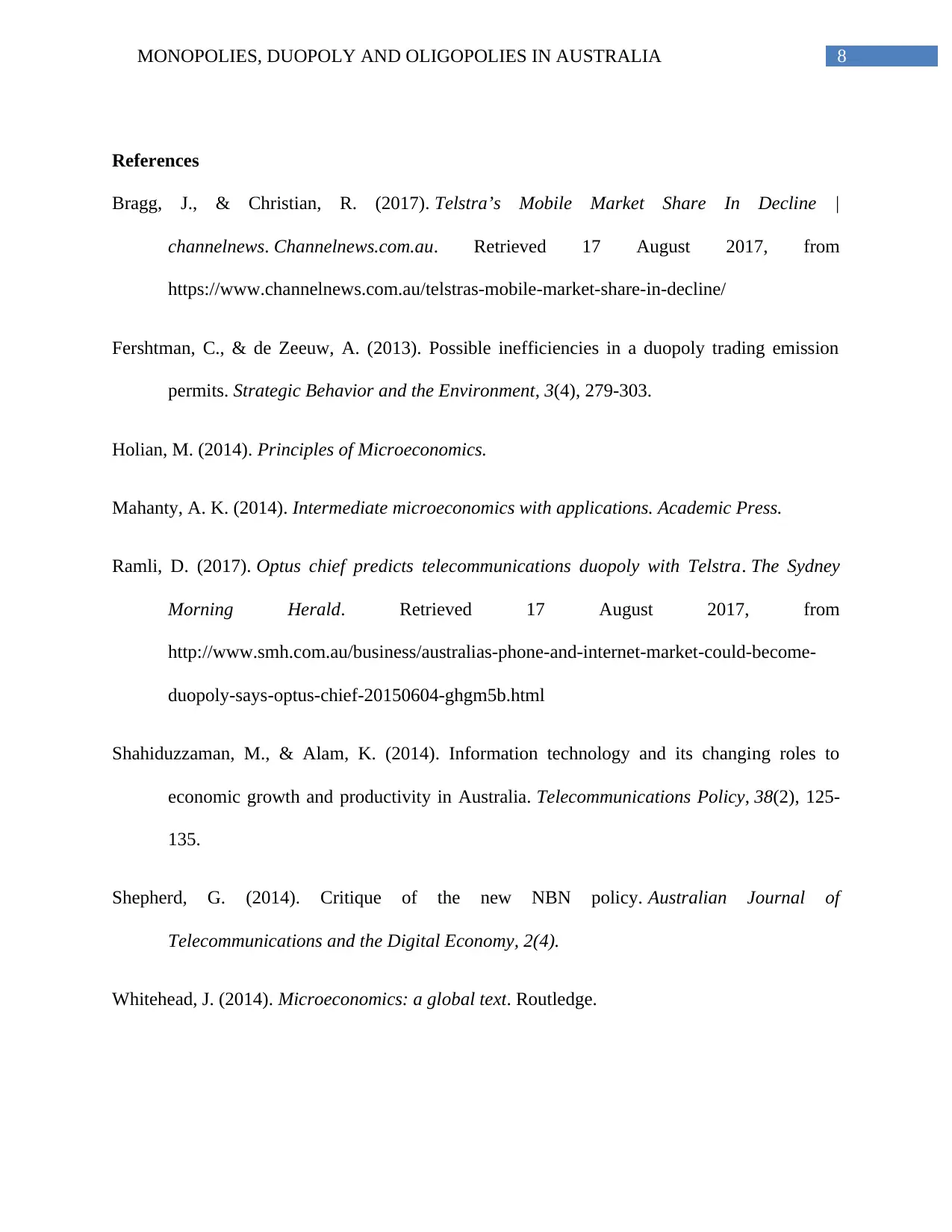
8MONOPOLIES, DUOPOLY AND OLIGOPOLIES IN AUSTRALIA
References
Bragg, J., & Christian, R. (2017). Telstra’s Mobile Market Share In Decline |
channelnews. Channelnews.com.au. Retrieved 17 August 2017, from
https://www.channelnews.com.au/telstras-mobile-market-share-in-decline/
Fershtman, C., & de Zeeuw, A. (2013). Possible inefficiencies in a duopoly trading emission
permits. Strategic Behavior and the Environment, 3(4), 279-303.
Holian, M. (2014). Principles of Microeconomics.
Mahanty, A. K. (2014). Intermediate microeconomics with applications. Academic Press.
Ramli, D. (2017). Optus chief predicts telecommunications duopoly with Telstra. The Sydney
Morning Herald. Retrieved 17 August 2017, from
http://www.smh.com.au/business/australias-phone-and-internet-market-could-become-
duopoly-says-optus-chief-20150604-ghgm5b.html
Shahiduzzaman, M., & Alam, K. (2014). Information technology and its changing roles to
economic growth and productivity in Australia. Telecommunications Policy, 38(2), 125-
135.
Shepherd, G. (2014). Critique of the new NBN policy. Australian Journal of
Telecommunications and the Digital Economy, 2(4).
Whitehead, J. (2014). Microeconomics: a global text. Routledge.
References
Bragg, J., & Christian, R. (2017). Telstra’s Mobile Market Share In Decline |
channelnews. Channelnews.com.au. Retrieved 17 August 2017, from
https://www.channelnews.com.au/telstras-mobile-market-share-in-decline/
Fershtman, C., & de Zeeuw, A. (2013). Possible inefficiencies in a duopoly trading emission
permits. Strategic Behavior and the Environment, 3(4), 279-303.
Holian, M. (2014). Principles of Microeconomics.
Mahanty, A. K. (2014). Intermediate microeconomics with applications. Academic Press.
Ramli, D. (2017). Optus chief predicts telecommunications duopoly with Telstra. The Sydney
Morning Herald. Retrieved 17 August 2017, from
http://www.smh.com.au/business/australias-phone-and-internet-market-could-become-
duopoly-says-optus-chief-20150604-ghgm5b.html
Shahiduzzaman, M., & Alam, K. (2014). Information technology and its changing roles to
economic growth and productivity in Australia. Telecommunications Policy, 38(2), 125-
135.
Shepherd, G. (2014). Critique of the new NBN policy. Australian Journal of
Telecommunications and the Digital Economy, 2(4).
Whitehead, J. (2014). Microeconomics: a global text. Routledge.
⊘ This is a preview!⊘
Do you want full access?
Subscribe today to unlock all pages.

Trusted by 1+ million students worldwide
1 out of 9
Related Documents
Your All-in-One AI-Powered Toolkit for Academic Success.
+13062052269
info@desklib.com
Available 24*7 on WhatsApp / Email
![[object Object]](/_next/static/media/star-bottom.7253800d.svg)
Unlock your academic potential
Copyright © 2020–2025 A2Z Services. All Rights Reserved. Developed and managed by ZUCOL.





